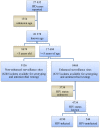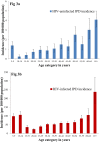HIV Infection and the Epidemiology of Invasive Pneumococcal Disease (IPD) in South African Adults and Older Children Prior to the Introduction of a Pneumococcal Conjugate Vaccine (PCV)
- PMID: 26863135
- PMCID: PMC4749259
- DOI: 10.1371/journal.pone.0149104
HIV Infection and the Epidemiology of Invasive Pneumococcal Disease (IPD) in South African Adults and Older Children Prior to the Introduction of a Pneumococcal Conjugate Vaccine (PCV)
Abstract
Introduction: Streptococcus pneumoniae is the commonest cause of bacteremic pneumonia among HIV-infected persons. As more countries with high HIV prevalence are implementing infant pneumococcal conjugate vaccine (PCV) programs, we aimed to describe the baseline clinical characteristics of adult invasive pneumococcal disease (IPD) in the pre-PCV era in South Africa in order to interpret potential indirect effects following vaccine use.
Methods: National, active, laboratory-based surveillance for IPD was conducted in South Africa from 1 January 2003 through 31 December 2008. At 25 enhanced surveillance (ES) hospital sites, clinical data, including HIV serostatus, were collected from IPD patients ≥ 5 years of age. We compared the clinical characteristics of individuals with IPD in those HIV-infected and -uninfected using multivariable analysis. PCV was introduced into the routine South African Expanded Program on Immunization (EPI) in 2009.
Results: In South Africa, from 2003-2008, 17 604 cases of IPD occurred amongst persons ≥ 5 years of age, with an average incidence of 7 cases per 100 000 person-years. Against a national HIV-prevalence of 18%, 89% (4190/4734) of IPD patients from ES sites were HIV-infected. IPD incidence in HIV-infected individuals is 43 times higher than in HIV-uninfected persons (52 per 100 000 vs. 1.2 per 100 000), with a peak in the HIV-infected elderly population of 237 per 100 000 persons. Most HIV-infected individuals presented with bacteremia (74%, 3 091/4 190). HIV-uninfected individuals were older; and had more chronic conditions (excluding HIV) than HIV-infected persons (39% (210/544) vs. 19% (790/4190), p<0.001). During the pre-PCV immunization era in South Africa, 71% of serotypes amongst HIV-infected persons were covered by PCV13 vs. 73% amongst HIV-uninfected persons, p = 0.4, OR 0.9 (CI 0.7-1.1).
Conclusion: Seventy to eighty-five percent of adult IPD in the pre-PCV era were vaccine serotypes and 93% of cases had recognized risk factors (including HIV-infection) for pneumococcal vaccination. These data describe the epidemiology of IPD amongst HIV-infected and -uninfected adults during the pre-PCV era and provide a robust baseline to calculate the indirect effect of PCV in future studies.
Conflict of interest statement
Figures




References
-
- Janoff EN, Breiman RF, Daley CL, Hopewell PC. Pneumococcal disease during HIV infection. Epidemiologic, clinical, and immunologic perspectives. Ann Intern Med. 1992;117(4):314–24. - PubMed
-
- Gilks CF, Ojoo SA, Ojoo JC, Brindle RJ, Paul J, Batchelor BI, et al. Invasive pneumococcal disease in a cohort of predominantly HIV-1 infected female sex-workers in Nairobi, Kenya. Lancet. 1996;347(9003):718–23. - PubMed
-
- Jones N, Huebner R, Khoosal M, Crewe-Brown H, Klugman K. The impact of HIV on Streptococcus pneumoniae bacteraemia in a South African population. AIDS. 1998;12(16):2177–84. - PubMed
-
- French N, Nakiyingi J, Carpenter LM, Lugada E, Watera C, Moi K, et al. 23-valent pneumococcal polysaccharide vaccine in HIV-1-infected Ugandan adults: double-blind, randomised and placebo controlled trial. Lancet. 2000;355(9221):2106–11. - PubMed
Publication types
MeSH terms
Substances
LinkOut - more resources
Full Text Sources
Other Literature Sources
Medical
Research Materials

